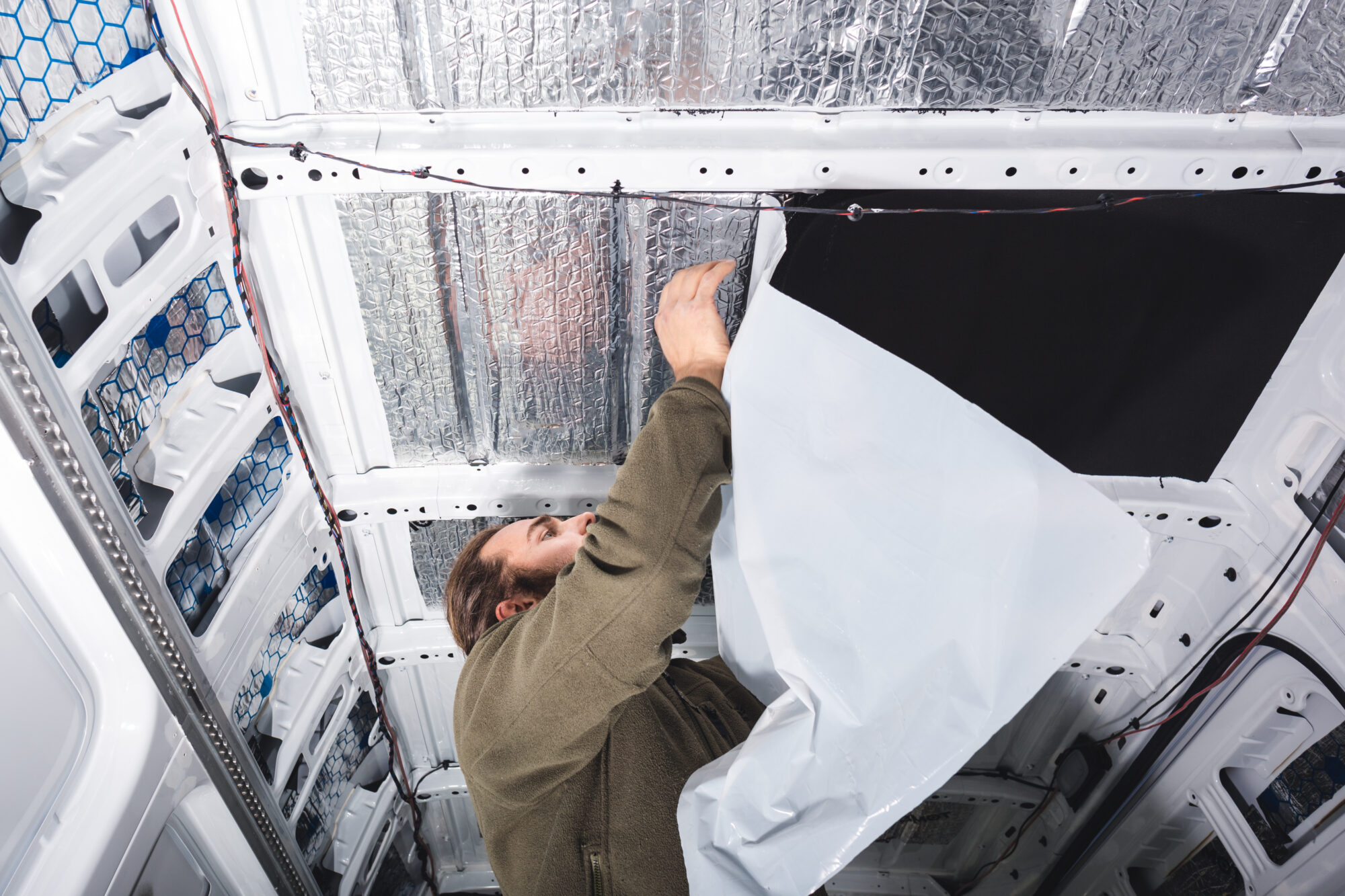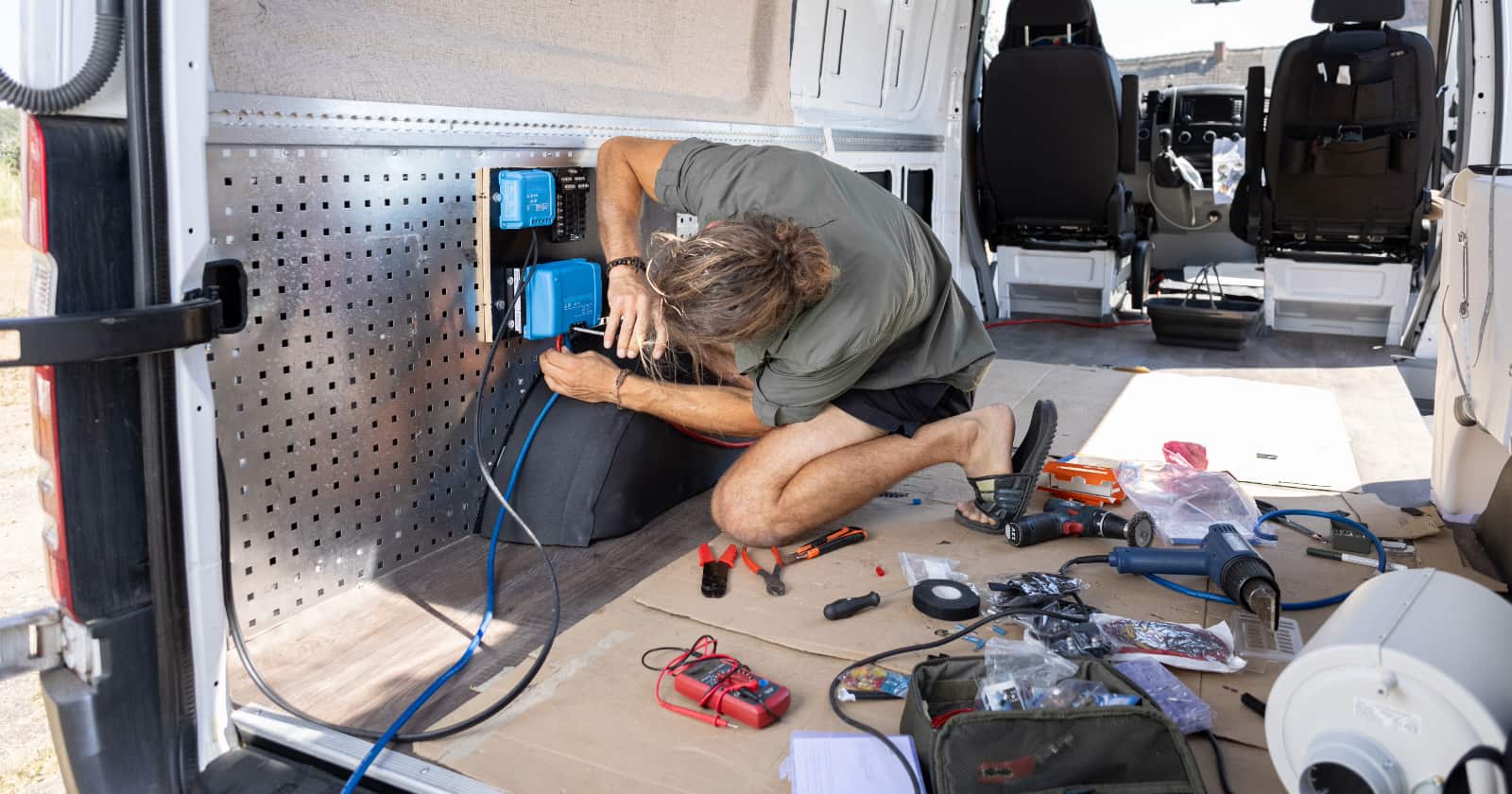What’s the Top Product to Insulate Your Van Conversion?
Properly insulating your camper van can make or break the build. Insulation protects you from both hot and cold weather so having the best insulation for a camper van conversion is key.

Planning a van conversion is a fun experience for most. Deciding on the layout and building out the interior and exterior features is exciting.
The most important work, however, takes place before any of the fun stuff. The wiring and plumbing may not be as fun. But those components are critical and needed before any interior work can be done. Insulation is hidden under the interior surfaces and is a very important part of the build as well.
Choosing the best insulation for camper vans and installing it correctly is a critical part of any van build. You’ve likely heard people referring to R-value when talking about insulation. Getting the highest R-value seems to be key. Is there more to insulation than just R-value?
What Is R-Value?
The R-value for insulation is a way to measure how much resistance the insulation has to heat flow. The higher the R-value, the more the material will keep heat in or out of the space.
Quite simply, when it’s hot outside, you want to block this heat from entering your van. And when it’s warm inside your van and cold outside, you want the heat to stay inside.
Insulation also provides some sound-deadening benefits which are beneficial when sleeping and working. An uninsulated van is a tin can that sound passes through and rattles around inside. The more insulation the quieter your van will be as well.
Do I Need To Insulate My Van?
Vans are essentially steel boxes that we drive around. Steel, although good for constructing vehicles, has very little insulating properties, and so gets very hot and very cold depending on the outdoor temperatures.
The metal used in vehicles is a thin gauge and not chosen for insulating or sound deadening. Both of these things are important in a van conversion. A completed camper van should be a comfortable place to sleep and even to live for some people.
Van used on a full-time or even on a regular basis should be insulated. This is especially important if you live or travel to locations with hot or cold weather. If you live in a comfortable climate and only use your van for weekends or short trips, you may be able to get away without insulation.
The process of insulating the van is not that difficult. And though it is an extra cost, it’s worth it. Keep in mind, insulation is one of the first steps, and once complete, it’s covered up, making it very difficult to go back and insulate a van you initially choose not to.
Vanlife can be addictive and it snowballs for many people. Just because you’re building a van for fair-weather weekend trips, doesn’t mean that won’t change. It’s very possible that the next year you’ll be heading out on a cross-country road trip or you’ll have relocated to somewhere with a different climate. Maybe you sell everything and go full-time!
The point is, to build your van for comfortable use long term and resale. Taking the steps to insulate your van will pay off in the end. Your van conversion will be more comfortable and quiet when properly insulated.

What Is The Best Insulation For A Camper Van?
When you mention insulation, most people think of the pink batts of insulation used in houses. This insulation is designed specifically for residential construction. House walls are constructed with 2×4 or 2×6 material allowing for thick batts of insulation.
Van conversions are built differently compared to a house. The walls and ceiling are very thin. This doesn’t allow for much insulation. The traditional batt insulation we commonly see in residential construction is much thicker than your van walls.
Although these batts are soft and can be compressed to a fraction of their original thickness, this is not how they were designed to work. Compressing batt insulation actually reduces its insulating properties.
So, what is the best insulation for a camper van? Two main types of insulation are used in van builds–ridged foam and spray insulation.
Ridged Foam Insulation
Ridged foam insulation comes in sheets like plywood and is most often white in color. It is available in various thicknesses so you can plan for the space you have in your walls, floor, and ceiling. Smaller pieces are also available if you don’t want to work with a large sheet of material.
Ridged foam is easy to cut and you can cover large areas in one piece in many situations. It doesn’t have much flex, and the thicker the material the less flex there is. This can be challenging in some areas such as curves in the side panels of vans.
Curved areas will take more work. Smaller pieces fitted together may have to be used. Another challenge with ridged foam can be your electrical and plumbing lines. If you have lines that will interfere with the insulation you may have to cut channels in the foam to route these lines.
Pro tip: A great way to make access for any electrical and plumbing lines is to melt the foam. Using a small touch, you can carefully melt a small recess in the areas you need.
When installing ridged foam insulation you will need a way to secure it in place. In some cases, you will have framing for the walls or ceiling to press the pieces between. Where this is not the case, you will need to secure the insulation in place.
Since the completed van will have multiple pieces of foam, there will be seams between those pieces. The best insulation job will require sealing these seams. This can be done by tapping the seams with ducted tape or a similar product.
R-Value
The R-value for ridged foam will depend on the thickness of the sheets you are using. In most builds, 1″ material is the go-to. There are also different density materials that will make a slight difference.
Ridged foam has an R-value of approximately R-4 per inch of material. Again, for a proper job and the best results, having tight seams and sealing them will keep you closer to this R-value.
Pros:
- Easy to work with and cut
- Cheap
- No special tools required
Cons:
- Doesn’t curve to surfaces
- There will be seams to seal
- Requires lots of measuring and cutting
Spray Foam Insulation
Spray insulation has become very common in the residential construction industry. It’s quick and easy to apply and forms a seamless seal. Therefore, it’s a great choice for vans.
Spray-in insulation has been used by lots of us to fill small voids and fill areas around doors and windows. Spray cans of insulation are widely available for homeowners and are used widely for filling small voids.
The insulation used in residential projects and van builds is similar to these simple cans, however on a larger scale. Spray insulation is applied using commercial sprayers, not small spray cans.
There are various types of spray insulation divided into two categories. Open-cell and closed-cell are the two main categories. Open-cell, as the name implies, is not as dense as closed-cell. For this reason, closed-cell has a higher insulating value, more sound deadening, and is more resistant to absorbing moisture.
For these reasons, closed-cell is a superior product. The beauty of spray foam insulation is the application is so fast. The surface to be sprayed is covered quickly and any electrical or plumbing within the surface can be safely sprayed over. There is no need to cut insulation or piece it around these obstacles.
The end result is seamless coverage on all surfaces regardless of shape. Since the product adheres to surfaces there is no need for securing it on overhead or angled surfaces.
R-Value
As with all insulation, R-value will depend on thickness. Open-cell spray has an R-value of approximately R-4 whereas closed-cell is R-7
Pros:
- Fully seals and insulates all surfaces
- Great sound-deadening properties
- Fast application
- Plumbing and electrical lines aren’t an issue
Cons:
- Special equipment needed
- Can be messy if not careful
- More expensive
Reflective Foam Core Radiant Barrier
Reflective barrier insulation is the silver-sided bubble wrap you see often used. Although this does work, it doesn’t have great insulating value.
Reflective foam core, on the other hand, is a better choice for a van build. The foam core gives it better insulating and sound-deadening characteristics. One great benefit of using rolls of this product is that it conforms to different shapes and curves in the van.
R-Value
There are many brands available, all claiming different R-values. Different thicknesses are also available and this, of course, will determine R-value. As a general guideline, an R-value of 7 all the way to 15 is possible.
Pros:
- Easy to install
- Works on curves and uneven surfaces
- Covers large area quickly
Cons:
- Can be expensive for the good stuff
- Better for warm climates than cold
Wool And Fiberglass Batts
The insulation used in residential construction can be used in your van conversion as well. It should be noted, batt style insulation is not designed to be compressed very much. Although it is easily compacted, doing so reduces its insulating properties.
A big factor to consider if using batt insulation is moisture. The temperature difference between the inside and outside of your van combined with the metal shell of the van is a prime environment for moisture. Wet batt insulation can form mold and so proper ventilation along with a moisture barrier is important.
R-Value
Batt-style insulation will be sold based on its R-value. The thicker it is, generally the higher the R-value. Fiberglass or wool batts will have an approximate R-value of R-3 per inch.
Keep in mind, if you are compacting it the R-value will be reduced. That being said, don’t buy thicker batts just to end up compacting them. Use the proper thickness batts for the best insulation for a camper van build.
Pros:
- Great for thicker spaces
- Can be stuffed into small areas if needed (with reduced effectiveness)
- Easy to cut
Cons:
- Can hold moisture
- Itchy to work with
The Best Insulation For A Camper Van Conversion Is…
The best insulation for a camper van conversion will be up to you and your build. One thing that that can be agreed upon, however, is insulating your van is a very worthwhile step.
Transforming an empty metal van into a cozy home-on-wheels takes planning and creativity. Picking the best products and using them correctly will pay off in the end.
Continue reading:
- 8 Van Heating Options to Keep Your Camper Van Warm This Winter
- 5 Van Build Mistakes That Can Ruin A Camper Van Conversion




You don’t mention Thinsulate which is the only acoustic & thermal insulation designed specifically for vehicles. It’s hydrophobic properties are essential in vans where there will be moisture present. Thinsulate is used in more vans than every other type of insulation combined.
We also use Minicell closed cell foam for insulating under floors. It too is highly popular.
All the best,
Hein
DIYvan
A couple of corrections on the type of insulation: it is ridgit, not ridged; Duct Tape not ductted tape, taping instead of tapping. Please watch the spelling of the words.
Also Duct tape is normally not used, there are better taping materials to cover gaps in the insulation.
Perfesserioneral Edtior here (you that read right).
.
“… Using a small touch…”
With a small torch, do I still need a small touch?
.
Rigid, not ridged nor ridgit.
1) You misconstrue R-value and material frequently. Ridgid insulation is not an insulation material, it is a method of construction. The R-value of rigid insulation also changes by the density of the material (listed in lbs per cubic foot). Both are important to know. The main material types are; Expanded Polystyrene (EPS), Extruded Polystyrene (XPS) and polyISOcyanurate (ISO)
High-Density EPS R-4.2 Per Inch
Low-Density EPS R-3.85 Per Inch
High-Density XPS R-5.2 Per Inch
Low-Density XPS R-4.15 Per Inch
ISO (Penthane Expanded, New Polyiso) R-6.8 Per Inch
2 )Reflective facing (foil) on insulation is a form of radiant barrier that is ONLY EFFECTIVE if there is an associated air gap (which is rare). When placing it in a cavity in an RV, there is no reflective capacity so you will obtain no benefit from using it. Many composite insulations consist of a conductive core and radiant skin and are rated using both values. Calculate their ‘installed’ insulating value by only considering only the conductive portion based on the material, density and thickness) so you can make the correct decisions on the material.
Suppliers claiming R-values higher than R-6.8/inch of ISO are calculating the potential for combined conductive and radiative performance of the insulation WITHOUT any consideration for installation conditions. Radiative performance will be virtually impossible to achieve in an RV. To be blunt, they are deceptive and outright lying. Be a knowledgeable buyer and break down the conductive and radiative performance separately so when you knowingly violate all of the radiative performance requirements (and you will) and are only left with the conductive performance, you can be truthful with yourself because mother nature only works on facts and sees through all the lies.
Understand how heat flows in your metal envelope at the macroscopic level. All those metal ‘tubes’ formed for stiffness, conduct most of the heat from the outside skin, through the metal connecting walls and re-radiate on the inside skin. They are so narrow (like double pane windows) that thermal convection and conduction are extremely small through the intervening air. Putting foam inside the tube does almost nothing to increase insulation because very little of the heat is communicated across (from panel to panel) those small spaces.
Installing your highest quality insulation in places that will BREAK thermally conductive paths is the key…..and obviously impossible to do if you attempt to keep all the insulation within the projection of the stiffeners. Thermal cameras are a great tool to evaluate where heat is conducted and therefore, where insulation is of the most value.
So who cares if van wall is thin? Not me. I have no problem putting 2×4 studs and using home insulation. That is one way of doing it, and I may just do that with my van conversion. Way I look at it that would save me time, and labor. I would insulate the van walls first, but I like straight wall, and that would do it for me. You don’t always have to do things the way others do. I helped when my grandfather made a log cabin, from very crooked logs. Simple, he put 2X12 studs every 3-4 feet, cut the trees into lengths that would fit between them, and the short sections were straight enugh to do that nicey. Likely it has been done before, but that was the only cabin I have ever seen made that way.
So, how much R value is enough for a van or a truck camper (which I’m building)? I want to use my coach three seasons, but have enough insulation for Midwestern winters.
Condensation forms on cold surfaces, for example, metal, even without the presence of people constantly breathing moisture into the air.
Please show evidence that over five years or more, moisture doesn’t become trapped behind the vapor barrier.